From the Cruiser Report - August 2025
The August 2025 From the Cruiser Report is now available to view at:
August 2025 From the Cruiser Report
This is a monthly newsletter from the Guysborough County Royal Canadian Mounted Police (RCMP) to inform residents of the monthly updates, activities and news stories.
Public Notice: Mandatory Water Conservation Order
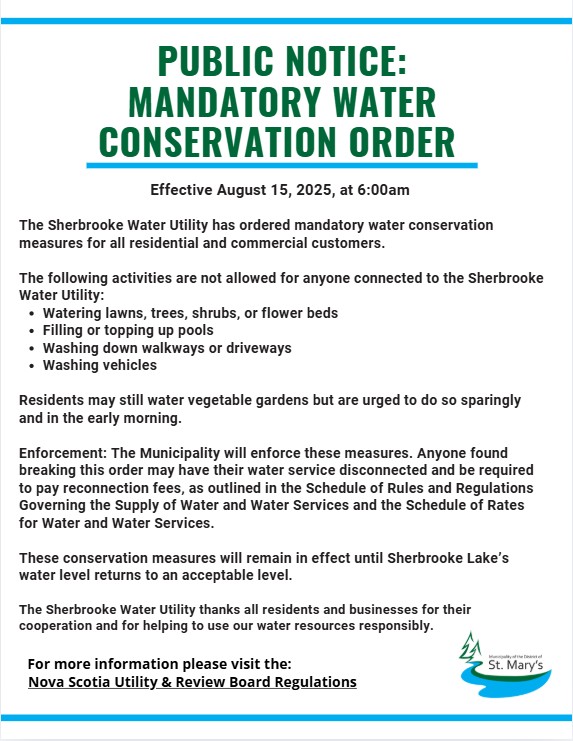
Effective August 15, 2025, at 6:00am
The Sherbrooke Water Utility has ordered mandatory water conservation measures for all residential and commercial customers.
The following activities are not allowed for anyone connected to the Sherbrooke Water Utility:
- Watering lawns, trees, shrubs, or flower beds
- Filling or topping up pools
- Washing down walkways or driveways
- Washing vehicles
Residents may still water vegetable gardens but are urged to do so sparingly and in the early morning.
Enforcement: The Municipality will enforce these measures. Anyone found breaking this order may have their water service disconnected and be required to pay reconnection fees, as outlined in the Schedule of Rules and Regulations Governing the Supply of Water and Water Services and the Schedule of Rates for Water and Water Services.
These conservation measures will remain in effect until Sherbrooke Lake’s water level returns to an acceptable level.
The Sherbrooke Water Utility thanks all residents and businesses for their cooperation and for helping to use our water resources responsibly.
For more information please visit the Nova Scotia Utility and Review Board regulations
Public Notice: Water Assistance
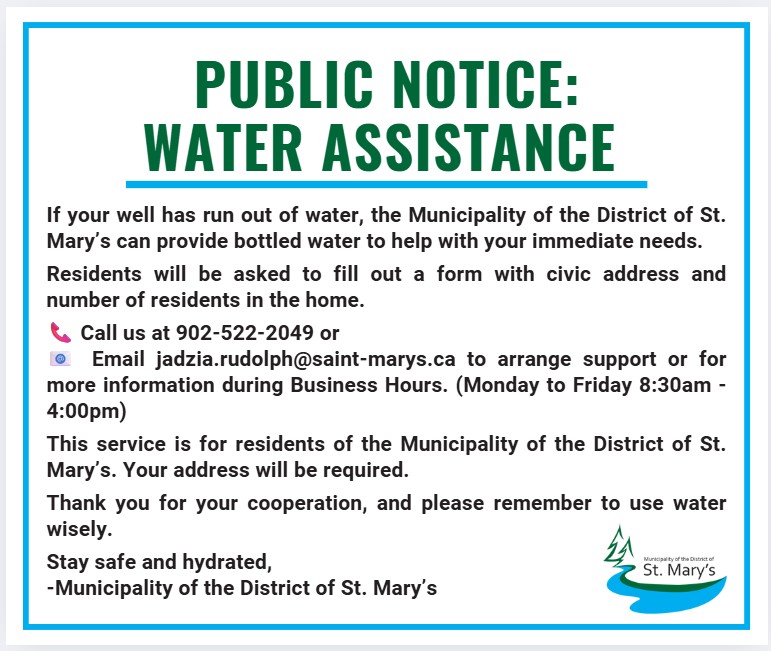
If your well has run out of water, the Municipality of the District of St. Mary’s can provide bottled water to help with your immediate needs.
Residents will be asked to fill out a form with civic address and number of residents in the home.
📞 Call us at 902-522-2049 or
📧 Email This email address is being protected from spambots. You need JavaScript enabled to view it. to arrange support or for more information during Business Hours. (Monday to Friday 8:30am - 4:00pm)
This service is for residents of the Municipality of the District of St. Mary’s. Your address will be required.
Thank you for your cooperation, and please remember to use water wisely.
Stay safe and hydrated,
-Municipality of the District of St. Mary’s
Municipal Facilities Closed - Labour Day
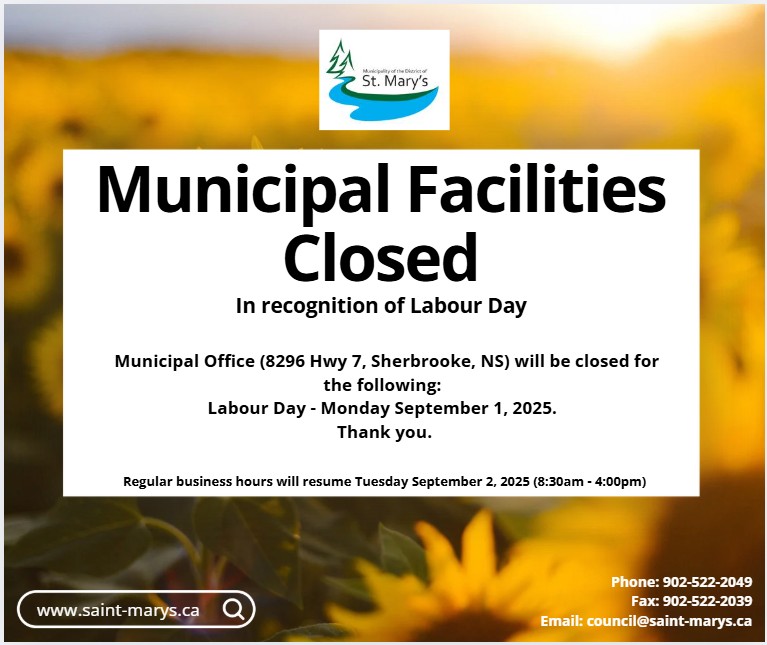
Municipal Office & Facilities Closed in recognition of Labour Day
Municipal Office (8296 Hwy 7, Sherbrooke, NS) will be closed for the following:
Labour Day - Monday September 1, 2025.
Regular business hours will resume Tuesday September 2, 2025 (8:30am - 4:00pm)
Thank you.
Special Council Meeting - September 3, 2025
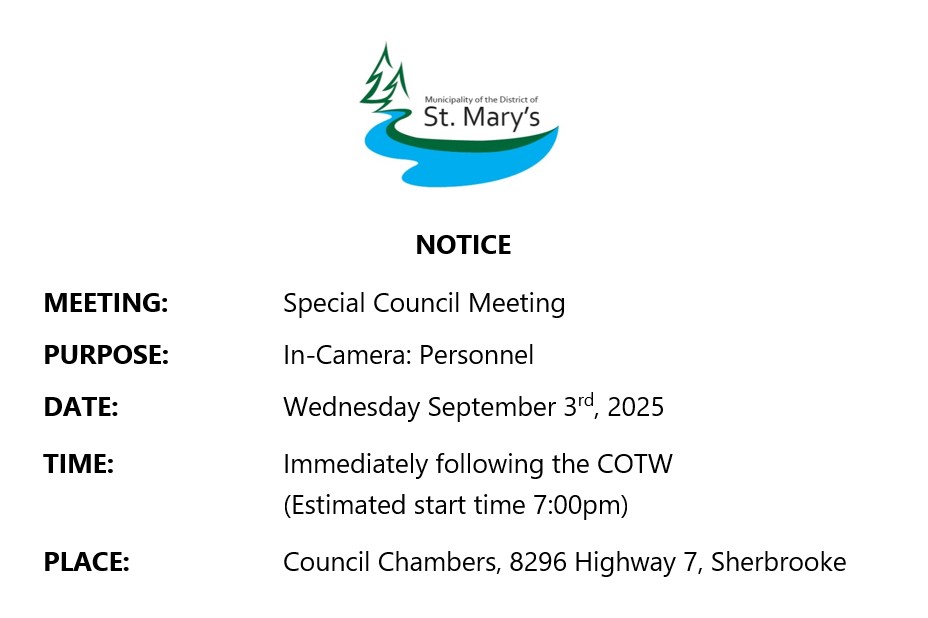
NOTICE
MEETING: Special Council Meeting
PURPOSE: In-Camera: Personnel
DATE: Wednesday September 3rd, 2025
TIME: Immediately following the COTW
(Estimated start time 7:00pm)
PLACE: Council Chambers, 8296 Highway 7, Sherbrooke
- Call to Order
- Roll Call
- Approval of the Agenda
- In-Camera: Personnel Matters
Adjournment
COTW - September 3, 2025
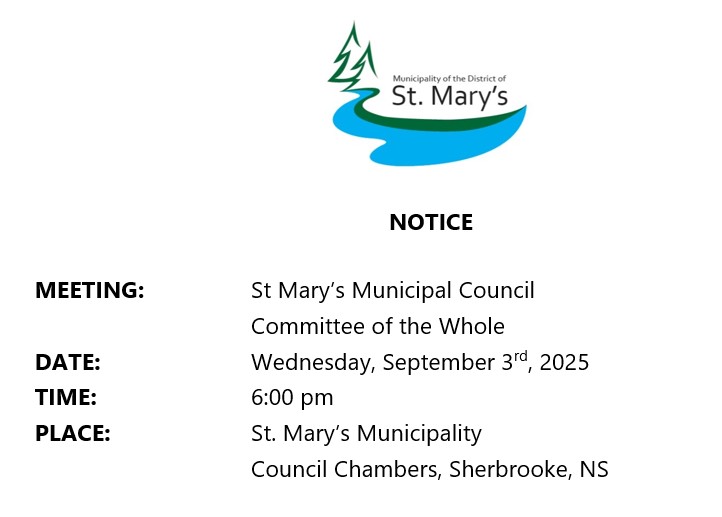
NOTICE
MEETING: St Mary’s Municipal Council
Committee of the Whole
DATE: Wednesday, September 3rd, 2025
TIME: 6:00 pm
PLACE: St. Mary’s Municipality
Council Chambers, Sherbrooke, NS
- Call to Order
- Roll Call
- Additions to the Agenda
- Approval of the Agenda
- Approval of Minutes of the Committee of the Whole held July 16th, 2025
- Business Arising from Minutes
a. Flag Policy
- Presentation: Access Wellness Program – Rob Wolf, Nova Scotia Health & Wellness
- Correspondence:
a. 2024-2025 Annual Report - Property Valuation Services Corporation
b. Code of Conduct Training – Paul LaFleche, Deputy Minister Dept. of Municipal Affairs
c. Community Impact Report – Eastern Counties Regional Library
d. Provincial Heritage Property – Dept. of Communities, Culture, Tourism and Heritage
e. Value for Money Audit of NS Firefighters School – Hon. John Lohr, Minister of Dept. of Municipal Affairs
f. Thank You Email – Dr. Ackermann & Dr. McLean – Doctor Recruitment
g. Thank You Card – Ava Anderson – Financial Award Scholarship
- Other Matters of Business
a. Staff Report - Provincial Volunteer Awards Ceremony
b. Nova Scotia Federation of Municipalities - Fall Conference – Attendance
c. Department of Public Works – J Class Road Submissions
d. Staff Report – Recplex Flooring
e. Staff Report – ZZAP Housing Policy Recommendations
- In- Camera: Contract Negotiations
Adjournment





